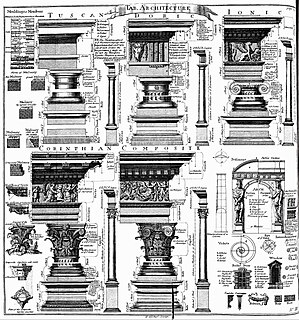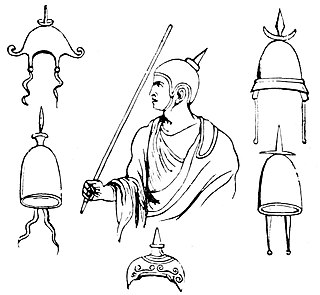
A column or pillar in architecture and structural engineering is a structural element that transmits, through compression, the weight of the structure above to other structural elements below. In other words, a column is a compression member. The term column applies especially to a large round support with a capital and a base or pedestal, which is made of stone, or appearing to be so. A small wooden or metal support is typically called a post. Supports with a rectangular or other non-round section are usually called piers.

An order in architecture is a certain assemblage of parts subject to uniform established proportions, regulated by the office that each part has to perform. Coming down to the present from Ancient Greek and Ancient Roman civilization, the architectural orders are the styles of classical architecture, each distinguished by its proportions and characteristic profiles and details, and most readily recognizable by the type of column employed. The three orders of architecture—the Doric, Ionic, and Corinthian—originated in Greece. To these the Romans added, in practice if not in name, the Tuscan, which they made simpler than Doric, and the Composite, which was more ornamental than the Corinthian. The architectural order of a classical building is akin to the mode or key of classical music; the grammar or rhetoric of a written composition. It is established by certain modules like the intervals of music, and it raises certain expectations in an audience attuned to its language.

Ancient Greek architecture came from the Greek-speaking people whose culture flourished on the Greek mainland, the Peloponnese, the Aegean Islands, and in colonies in Anatolia and Italy for a period from about 900 BC until the 1st century AD, with the earliest remaining architectural works dating from around 600 BC.

In architecture, an abacus is a flat slab forming the uppermost member or division of the capital of a column, above the bell. Its chief function is to provide a large supporting surface, tending to be wider than the capital, as an abutment to receive the weight of the arch or the architrave above. The diminutive of abacus, abaculus, is used to describe small mosaic tiles, also called abaciscus or tessera, used to create ornamental floors with detailed patterns of chequers or squares in a tessellated pavement.

In architecture, a cornice is generally any horizontal decorative moulding that crowns a building or furniture element—for example, the cornice over a door or window, around the top edge of a pedestal, or along the top of an interior wall. A simple cornice may be formed just with a crown, as in crown moulding atop an interior wall or above kitchen cabinets or a bookcase.

In classical architecture, an architrave is the lintel or beam that rests on the capitals of columns.

In heraldry, an ordinary is a simple geometrical figure, bounded by straight lines and running from side to side or top to bottom of the shield. There are also some geometric charges known as subordinaries, which have been given lesser status by some heraldic writers, though most have been in use as long as the traditional ordinaries. Diminutives of ordinaries and some subordinaries are charges of the same shape, though thinner. Most of the ordinaries are theoretically said to occupy one-third of the shield; but this is rarely observed in practice, except when the ordinary is the only charge.

Isernia is a town and comune in the southern Italian region of Molise, and the capital of province of Isernia.

Moulding, also known as coving(United Kingdom, Australia), is a strip of material with various profiles used to cover transitions between surfaces or for decoration. It is traditionally made from solid milled wood or plaster, but may be of plastic or reformed wood. In classical architecture and sculpture, the molding is often carved in marble or other stones.

The hypotrachelium is the upper part or groove in the shaft of a Doric column, beneath the trachelium. The Greek form is hypotrakhelion.

The apex was a cap worn by certain priests, the flamines and Salii, in ancient Rome.
This page is a glossary of architecture.

The Sun Temple is a Hindu temple dedicated to the solar deity Surya located at Modhera village of Mehsana district, Gujarat, India. It is situated on the bank of the river Pushpavati. It was built after 1026-27 CE during the reign of Bhima I of the Chaulukya dynasty. No worship is offered now and is protected monument maintained by Archaeological Survey of India. The temple complex has three components: Gudhamandapa, the shrine hall; Sabhamandapa, the assembly hall and Kunda, the reservoir. The halls have intricately carved exterior and pillars. The reservoir has steps to reach the bottom and numerous small shrines.
Taenia or tænia, from Greek ταινία and Latin taenia may refer to:

A fish fillet, from the French word filet meaning a thread or strip, is the flesh of a fish which has been cut or sliced away from the bone by cutting lengthwise along one side of the fish parallel to the backbone. In preparation for filleting, any scales on the fish should be removed. The contents of the stomach also need careful detaching from the fillet. Because fish fillets do not contain the larger bones running along the vertebrae, they are often said to be "boneless". However, some species, such as the common carp, have smaller intramuscular bones called pins within the fillet. The skin present on one side may or may not be stripped from the fillet. Butterfly fillets can be produced by cutting the fillets on each side in such a way that they are held together by the flesh and skin of the belly.

Fluting in architecture consists of shallow grooves running along a surface.
A fillet was originally worn in classical antiquity, especially in cultures of the Mediterranean, Levant and Persia, including Hellenic culture. At that time, a fillet was a very narrow band of cloth, leather or some form of garland, frequently worn by athletes. It was also worn as a sign of royalty and became symbolized in later ages as a metallic ring which was a stylized band of cloth.

A roundel is a circular charge in heraldry. Roundels are among the oldest charges used in coats of arms, dating from the start of the age of heraldry in Europe, circa 1200–1215. Roundels are typically a solid colour but may be charged with an item or be any of the furs used in heraldry. Roundels are similar to the annulet, which some heralds would refer to as a false roundel.
















